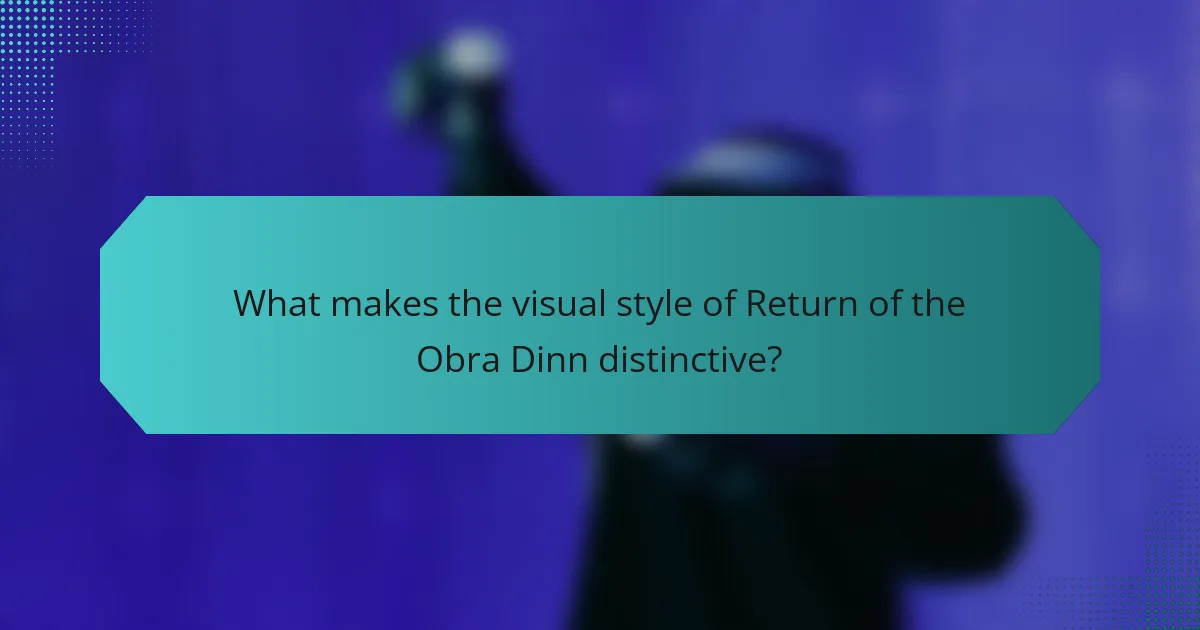Return of the Obra Dinn captivates players with its unique visual style, innovative gameplay mechanics, and engaging mystery elements. The game’s distinctive monochromatic palette enhances its atmospheric immersion. Players explore the narrative through a time-rewind mechanic, solving intricate puzzles to uncover the fate of the ship’s crew. This combination of art direction and interactive storytelling fosters deep player engagement and critical thinking.

What makes the visual style of Return of the Obra Dinn distinctive?
The visual style of Return of the Obra Dinn is distinctive due to its unique monochromatic palette and 1-bit graphics. This design choice evokes a sense of nostalgia reminiscent of early computer games. The use of a limited colour scheme enhances the game’s mysterious atmosphere and aligns with its theme of investigation. The innovative art direction, combined with the game’s narrative structure, creates an immersive experience that encourages players to engage deeply with the unfolding mystery. The visual style not only sets the tone but also serves as a crucial gameplay mechanic, guiding players through the intricate story.
How does the monochromatic palette enhance the storytelling?
The monochromatic palette enhances storytelling by creating a cohesive atmosphere that emphasizes emotions and themes. This visual style immerses players in the game’s mystery, directing focus on narrative elements rather than distractions. The limited colour scheme evokes a sense of nostalgia and aligns with the game’s historical context, reinforcing the investigative experience. By utilizing shades of black, white, and grey, the game visually represents the moral ambiguities and complexities of its narrative, deepening player engagement and interpretation.
Which artistic influences shaped the game’s aesthetic?
The game’s aesthetic is shaped by influences from 19th-century maritime art and early computer graphics. The visual style mimics the look of monochromatic, low-resolution graphics reminiscent of classic adventure games. This unique approach enhances the mystery elements, creating an immersive atmosphere. Influences from artists like J.M.W. Turner contribute to the game’s dramatic lighting and atmospheric effects, while the use of a limited colour palette evokes nostalgia and focuses attention on the narrative.
What role does pixel art play in player immersion?
Pixel art enhances player immersion in “Return of the Obra Dinn” by creating a distinct visual style that evokes nostalgia and supports its mystery elements. The game’s limited colour palette and geometric shapes foster a unique atmosphere, encouraging players to engage deeply with the narrative. Additionally, the pixelated graphics allow for imaginative interpretation, making players feel more connected to the unfolding story. This innovative approach to art direction complements the gameplay mechanics, reinforcing the overall immersive experience.

How does the mystery element drive player engagement?
The mystery element significantly enhances player engagement by fostering curiosity and critical thinking. Players are drawn into the narrative as they must solve intricate puzzles and uncover the fate of the ship’s crew. This interactive mystery encourages exploration and rewards players with a sense of accomplishment upon solving each case. The unique visual style of “Return of the Obra Dinn” complements this by creating an immersive atmosphere that heightens the overall experience. Engaging with the mystery element transforms gameplay into a captivating detective journey, making players invested in the outcome.
What are the key narrative techniques used in the game?
Return of the Obra Dinn employs several key narrative techniques that enhance its mystery and engagement. The game uses a unique visual style that mimics 19th-century aesthetics, creating an immersive atmosphere. Flashbacks reveal the fates of crew members, allowing players to piece together the story. The non-linear storytelling invites exploration and deduction, as players must infer connections between events. Additionally, the use of a death recording mechanic challenges players to solve each character’s demise, deepening the narrative experience.
How does player agency influence the mystery-solving experience?
Player agency significantly enhances the mystery-solving experience in “Return of the Obra Dinn.” It empowers players to make choices, explore, and engage with the narrative actively. This involvement fosters deeper emotional connections and investment in the unfolding story. The game’s unique visual style complements this by creating an immersive environment where players feel their decisions directly impact the outcome. As a result, the gameplay mechanics encourage critical thinking and deduction, making each revelation more rewarding.
Which character arcs contribute to the overarching enigma?
The character arcs in “Return of the Obra Dinn” deepen the overarching enigma by revealing interconnected fates. Each character’s backstory and choices contribute layers to the mystery, enhancing player engagement. The unique attribute of non-linear storytelling allows players to piece together narratives, fostering a sense of discovery. For example, the arc of the captain showcases leadership challenges that impact crew dynamics, while the unique fates of individual crew members highlight themes of loyalty and betrayal. These elements collectively enrich the game’s immersive experience.

What innovative gameplay mechanics set Return of the Obra Dinn apart?
Return of the Obra Dinn features innovative gameplay mechanics that emphasize deduction and exploration. Players investigate the fates of crew members through a unique time-rewind mechanic, allowing them to witness pivotal moments. This approach fosters critical thinking and immersive storytelling. The game’s monochromatic visual style enhances its mystery, creating a distinctive atmosphere that complements the gameplay. Additionally, the use of a non-linear narrative encourages players to piece together clues at their own pace, making each discovery rewarding and engaging.
How does the time rewind feature enhance puzzle-solving?
The time rewind feature enhances puzzle-solving by allowing players to experiment with different approaches without permanent consequences. This mechanic fosters creativity and exploration, enabling players to piece together clues more effectively. By reversing actions, players can revisit critical moments, gaining insights that lead to solving complex mysteries. This innovative gameplay mechanic is a unique attribute of “Return of the Obra Dinn,” setting it apart in the puzzle genre.
What unique investigative tools are available to players?
Players in “Return of the Obra Dinn” utilize unique investigative tools like the Memento Mortem, which reveals the last moments of deceased crew members. This innovative gameplay mechanic enhances the mystery elements, allowing players to piece together the narrative through visual clues and audio cues. The game’s distinctive art style complements these tools, creating an immersive experience that challenges players to solve intricate puzzles. The combination of these elements sets the game apart in the mystery genre.
Which interactions challenge traditional gaming conventions?
“Return of the Obra Dinn” challenges traditional gaming conventions through its distinctive visual style, intricate mystery elements, and innovative gameplay mechanics. The monochromatic graphics create a unique aesthetic, enhancing the immersion into the game’s narrative. Players engage in deduction-based gameplay, solving mysteries by piecing together clues, which deviates from typical action-oriented mechanics. The game’s time-traveling mechanic allows players to explore different timelines, offering a rare interactive experience that emphasizes critical thinking over reflexes. These elements combine to create a fresh approach to storytelling in video games.

How does player feedback shape the game’s design and updates?
Player feedback significantly influences the design and updates of “Return of the Obra Dinn” by guiding developers on gameplay mechanics and narrative elements. Feedback helps identify areas needing improvement, such as puzzle difficulty and user interface clarity. This iterative process ensures that the game remains engaging and accessible. Unique aspects like its monochromatic visual style and mystery-solving elements are refined based on player experiences, enhancing overall immersion. Continuous updates based on feedback foster a dedicated community and improve player satisfaction.
What common player challenges have emerged in gameplay?
Players of “Return of the Obra Dinn” often face challenges related to its unique gameplay mechanics and visual style. The game’s intricate mystery elements can lead to confusion, particularly in identifying crew members and their fates. The non-linear storytelling requires players to piece together information from various sources, which can be overwhelming. Additionally, the monochromatic art style, while distinctive, may strain some players’ ability to discern details. Lastly, the time constraints in certain scenarios can heighten the sense of urgency and pressure, complicating decision-making.
How do community discussions influence game strategies?
Community discussions significantly shape game strategies by fostering collaboration and sharing insights among players. Players analyze the unique visual style, mystery elements, and innovative gameplay mechanics of “Return of the Obra Dinn,” leading to diverse strategies. These discussions highlight root attributes like deduction skills and unique attributes such as narrative depth, influencing how players approach problem-solving. As a result, strategies evolve based on collective experiences and interpretations, enhancing overall gameplay engagement.

What lessons can be learned from Return of the Obra Dinn for future game development?
Return of the Obra Dinn teaches valuable lessons for future game development, particularly in visual storytelling and player engagement. Its unique visual style, utilizing monochrome graphics, enhances atmospheric immersion. The mystery elements encourage critical thinking and deduction, fostering deeper player involvement. Innovative gameplay mechanics, like time manipulation for narrative exploration, promote non-linear storytelling. These aspects highlight the importance of artistic vision and interactive design in creating memorable gaming experiences.
Which design principles can enhance narrative-driven games?
Narrative-driven games can enhance player engagement through immersive storytelling, visual aesthetics, and interactive mechanics. Key design principles include:
1. Cohesive Visual Style: A unique art direction, like the monochromatic graphics in Return of the Obra Dinn, reinforces the narrative and evokes emotions.
2. Environmental Storytelling: Use environments to convey backstory and context, allowing players to discover the narrative organically.
3. Player Agency: Provide choices that impact the story, enhancing immersion and emotional investment.
4. Mystery Elements: Incorporate puzzles and clues that challenge players, encouraging exploration and critical thinking.
5. Innovative Gameplay Mechanics: Introduce mechanics that align with the narrative, such as deduction systems that deepen the mystery experience.
How can innovative mechanics improve player retention?
Innovative mechanics enhance player retention by fostering engagement through unique gameplay experiences. “Return of the Obra Dinn” employs mystery elements and a distinctive visual style to captivate players. These mechanics encourage exploration and critical thinking, leading to deeper emotional investment. Players are more likely to return when they feel challenged and intrigued by the game’s innovative design.
What best practices should developers consider for mystery genres?
Developers should prioritize immersive storytelling, atmospheric design, and player agency in mystery genres. Engaging narratives enhance player investment, while unique visual styles, like that of Return of the Obra Dinn, create memorable experiences. Implementing innovative gameplay mechanics encourages exploration and critical thinking, essential for unraveling mysteries. Balancing clues and challenges maintains player interest and fosters satisfaction upon resolution.